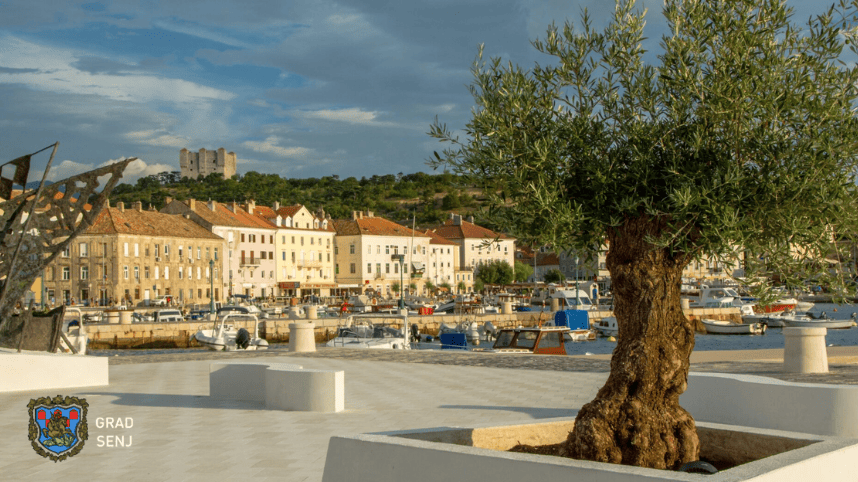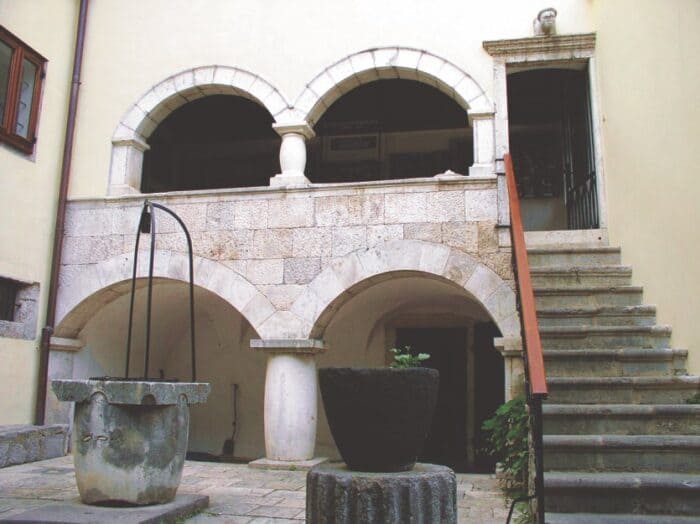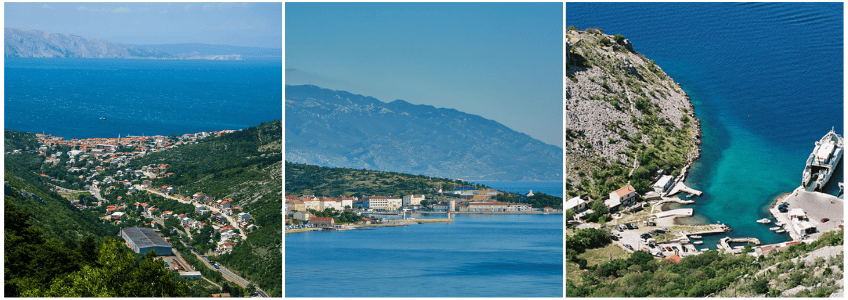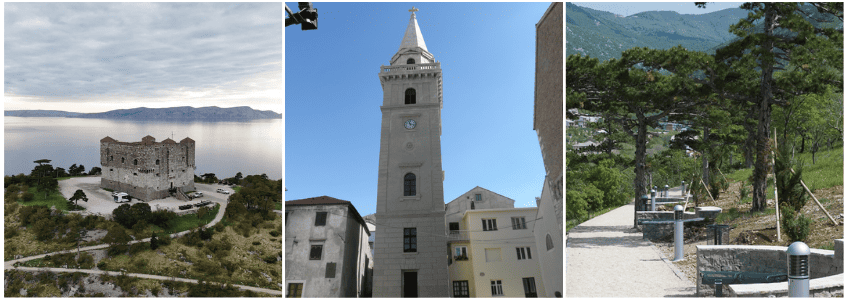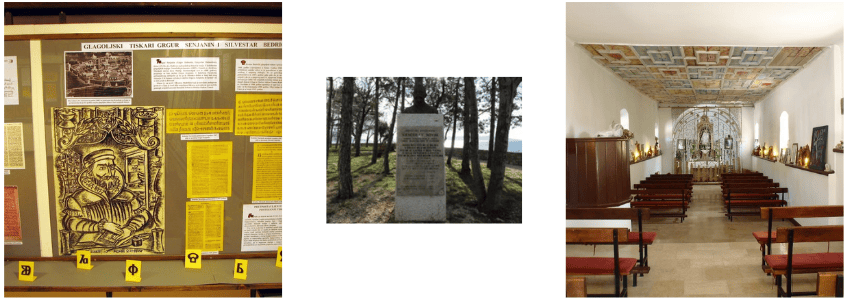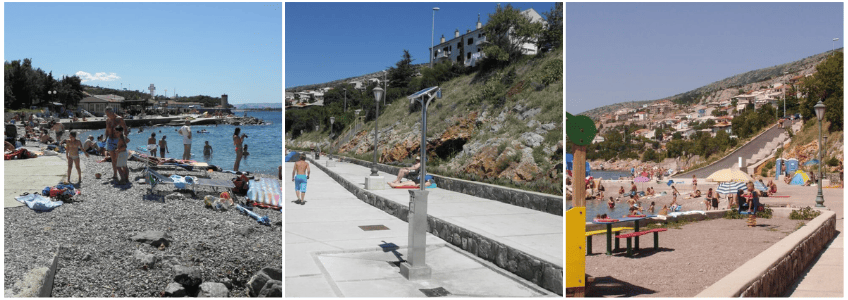The City of Senj is the largest urban agglomeration on the Croatian coast between Rijeka and Zadar
The city’s territory includes 76 km of coastline and is situated between the sea and the slopes of Kapela and Velebit, Croatia’s largest mountain. It lies at 14° 54′ 10″ east longitude and 44° 59′ 24″ north latitude. Its position on the eastern Adriatic coast provides maritime connections with Mediterranean cities and countries. By road, it is linked to the hinterland via the Vratnik mountain pass (700 m above sea level), to the west with the Vinodol Valley, Rijeka and its hinterland, and to the south with Zadar, Split, and southern Dalmatia.
History
City of Senj is one of the oldest settlements on the Adriatic, with origins over 3,000 years old. Initially located on Kuk Hill, it developed as a trading post between the coast, islands, and inland areas. In Roman times (Senia), it became a major trade and cultural center with advanced infrastructure and rich architecture.
In the early Middle Ages, the city declined due to the Migration Period, but the Croats rebuilt it on ancient ruins. From the 12th century, Senj regained importance, becoming a bishop’s seat and a center of Glagolitic literacy. In the 15th century, it became a military stronghold against the Ottomans and Venice, with the Senj Uskoks entering legend.
Peaceful periods in the 18th and 19th centuries brought economic growth, the construction of the Jozefina Road, and the development of its port, which became one of Croatia’s most important. Senj also flourished culturally, producing renowned writers.
The bypassing of the railway line in 1873 led to economic decline. In the 20th century, especially after World War II, the city lost population and significance but preserved valuable cultural heritage, making it an attractive destination today.
In Senj, the sea meets the mountains, offering a blend of unspoiled nature, fresh air, and rich history
The city, over three thousand years old, is renowned for its cultural heritage, the Glagolitic script, and landmarks such as the Nehaj Fortress, built in 1558.
The Senj area covers more than 650 km² and includes a number of coastal settlements along the Velebit Channel – Bunica, Sveta Jelena, Sveti Juraj, Lukovo Otočko, Klada, Starigrad, Jablanac, Stinica, and Prizna – as well as mountain villages in the Velebit and Kapela ranges – Krasno, Krivi Put, Stolac, Crni Kal, and Vratnik. Its natural treasures are protected within the Velebit Nature Park and the Northern Velebit National Park.
The city and its surroundings offer a rich cultural and entertainment program: carnivals, Uskok Days, klapa singing festivals, fishermen’s feasts, concerts, and fairs. Both sea and mountains provide opportunities for diving, sailing, fishing, hiking, cycling, hunting, caving, and winter sports – a rare chance to enjoy both seaside and mountain adventures in the same day.
Cultural Heritage
Nehaj Fortress
Built in 1558 under the command of Ivan Lenković and Herbert VIII. Auersperg, using stones from demolished churches and houses outside the city walls. It has a square shape (18 m high, 23 m wide) with thick walls, corner towers, and cannon openings. Inside are a cistern with builders’ coats of arms, rooms for soldiers and officers, and a cannon battery. Today it serves as a museum and viewpoint with views of the Adriatic coast and islands, and hosts cultural events.
Cathedral of the Assumption of the Blessed Virgin Mary
The most significant religious and cultural monument in Senj, built in 1169 on the foundations of an ancient sanctuary and early Christian structure. In the 18th century, it was expanded with side aisles, containing valuable artworks such as the Gothic tomb of Bishop Ivan Cardinalibus and the Relief of the Holy Trinity with the oldest known Croatian coat of arms (1491). Heavily damaged in World War II, restored in 1949–1950. Beneath the altar are bishops’ tombs, and smaller chapels once surrounded the cathedral.
Sacred Heritage – Permanent Exhibition of Church Art
Established in 1987, featuring items from the treasury of Senj Cathedral, archives, and the diocesan library. Displays include liturgical vessels, bishops’ portraits, relics from other Senj churches, keys to the city of Klis, and furniture from Bishop Ožegović’s era. Open to visitors daily in summer and on weekdays during the rest of the year.
Glagolitic Script – Senj Printing House
Senj is, among other things, known as a Glagolitic city. The Senj Stone, found on the staircase of Nehaj Fortress during restoration works, testifies that the Glagolitic script was already as widespread in the 11th century as it was on the nearby island of Krk.
Glagolitic Script – Senj Printing House
Senj is, among other things, known as a Glagolitic city. The Senj Stone, found on the staircase of Nehaj Fortress during restoration works, shows that the Glagolitic script was already widely used in the 11th century, just like on neighboring Krk. It is one of the oldest Croatian Glagolitic monuments, created almost at the same time as the Baška Tablet. It has not been preserved in its entirety; only fragments with carved floral ornaments and Glagolitic letters have been found. These preserved fragments are now kept in the Senj City Museum.
Park of Senj Writers
The city of Senj, where some of the most renowned Croatian writers and poets of their time were born and lived (Silvije Strahimir Kranjčević, Milutin Cihlar Nehajev, Vjenceslav Novak, Milan Ogrizović, Pavao Ritter Vitezović), has also dedicated a park to them above the old city beach, where their busts have been placed.
Events in Senj
- Senj Carnival (Winter & Summer) – Centuries-old tradition where “maškare” (masked participants) take over the town. The winter carnival runs from early January to Ash Wednesday with masked balls every weekend, while the summer carnival in early August draws thousands of costumed participants and international groups in a grand parade.
- City Day – Feast of St. George (April 23) – Celebrated with cultural and social events, including a formal City Council session where awards are presented to distinguished citizens.
- Night of Fortresses – Cross-border cultural event held at Nehaj Fortress, linking 45 fortifications across three countries and promoted at the European level as part of the European Fortress Summer.
- “Senjski Vitezovi” Memorial Cadet Taekwondo Tournament – Annual youth competition organized by the Senj Taekwondo Club, active since 1993.
- Senj Concert Evenings – Free classical music concerts from June to August in the Cathedral of the Assumption, featuring renowned ensembles and young talents.
- “Tenis” Mini Football Tournament – Sports-entertainment event held since 1964 at the renovated Tenis sports grounds in late June, featuring football stars past and present.
- Cycling Race “Ascent to Zavižan” – Challenging international uphill race from Senj (0 m) to Zavižan (1,594 m), first held in 2003, attracting about 400 cyclists each year.
- Senj Klapa Festival – Held since 1998 (roots from 1973) each July, showcasing traditional and new songs performed by male and female “klapa” vocal groups from Primorje and Istria.
- Senj Sailing Regatta – Summer sports event adding to the town’s seasonal attractions.
- Honey Days – Annual August fair at Pavlin Square, organized by local beekeepers, offering honey products, tastings, and educational activities.
Sports and Activities
- Cycling – The climate and terrain of Senj and its surroundings make it an ideal year-round cycling destination.
- Hiking – Well-marked hiking trails and walking paths are available in the Senj area.
- Diving – The eastern Adriatic coast has been a sailing route from East to West since ancient times, with remnants still visible on land and underwater.
- Sailing – Numerous bays and hidden beaches make sailing in the Senj waters a true pleasure for sea and wind enthusiasts.
- Fishing – A permit is required for recreational and sport fishing in Croatian waters, whether from shore or boat.
- Hunting – The Senj area has many hunting grounds, rich in wildlife such as brown bear, roe deer, chamois, fallow deer, wild boar, and mouflon.
- Sports and Recreation Center “Tenis” – Located on Nehaj Hill within Nehaj Park, it offers a gym, outdoor workout area, two mini football fields, a tennis court, two table tennis tables, and a children’s playground.
To learn more about local administration, services, and community updates, visit the official website of the City of Senj.
